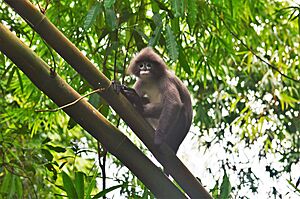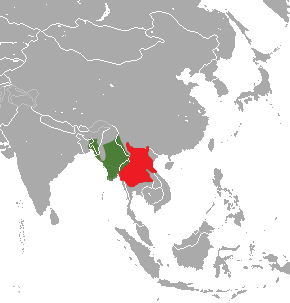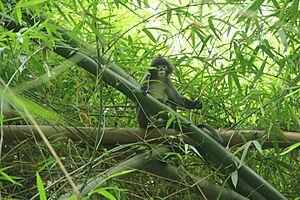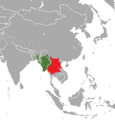Phayre's leaf monkey facts for kids
Quick facts for kids Phayre's leaf monkey |
|
|---|---|
 |
|
| In Lawachara National Park | |
| Conservation status | |
| Scientific classification | |
| Genus: |
Trachypithecus
|
| Species: |
phayrei
|
 |
|
| Phayre's leaf monkey range in green (includes T. melamera) | |
The Phayre's leaf monkey (Trachypithecus phayrei) is also known as Phayre's langur. It is a type of Old World monkey. You can find these monkeys in parts of South Asia and Southeast Asia. This includes countries like India, Bangladesh, and Myanmar.
Sadly, this monkey is listed as Endangered on the IUCN Red List. This means its population is at risk. The main threats are hunting and losing their homes, which is called loss of habitat. The monkey's name honors Arthur Purves Phayre.
Contents
About Phayre's Leaf Monkey
The scientific name Presbytis phayrei was first used in 1847. It was given by Edward Blyth for two young monkeys found in Myanmar. Scientists often study animals to understand them better. They sometimes change how they group animals as they learn more.
Today, scientists believe there are three different species. These are T. phayrei, T. melamera, and T. popa. The name Phayre's leaf monkey now refers to T. phayrei. This specific monkey lives in forests in East Bengal, Northeast India, and western Myanmar.
What Phayre's Leaf Monkeys Look Like
Phayre's langurs are easy to spot because of their unique look. They have white fur around their mouth and eyes. The white patches around their eyes look like spectacles or glasses. This is why they are sometimes called "spectacled monkeys."
Their body fur is a deep bluish-brown. The white fur around their face stands out a lot against this darker color. Their head, elbows, and tail end are even darker. Both male and female adults have a triangular-shaped head. This is because of a small ridge on top of their heads.
Baby Phayre's langurs are born with straw-colored fur. This makes them easy to tell apart from the adults in a group. Adult males are usually about 53 to 58 centimeters (21-23 inches) long. Females are slightly smaller, from 49.5 to 58 centimeters (19.5-23 inches). Their tail is often longer than their body. Males have tails around 70 centimeters (27.5 inches) and females around 75 centimeters (29.5 inches).
Males weigh about 7.9 kilograms (17.4 pounds). Females are a bit lighter, around 6.9 kilograms (15.2 pounds). You can sometimes tell males and females apart by the shape of their eye patches. Females have cone-shaped patches that bend towards their nose. Males have rounder patches.
Like most Old World monkeys, they have a specific set of teeth. They have strong jaw muscles. This helps them eat seeds, which are a big part of their diet.
Where They Live and Their Home
Phayre's langurs live in different types of forests. These include tropical, deciduous, and evergreen forests. You can find them in North-East India, Eastern Bangladesh, and Western Myanmar.
They can also live in forests that have grown back after being cut down. This includes bamboo areas and rubber tree farms. They like to rest in trees with big canopies. These trees provide good shade. Some common resting trees in Bangladesh are Artocarpus chama and Ficus racemosa. In India, they use trees like Ficus hispida.
Scientists have counted about 1200 Phayre's langurs in India. In Bangladesh, there are about 376 individuals. Most of these live in the northeastern forests of Bangladesh.
Behavior and Life Cycle
Group Structure
Phayre's langurs usually live in groups with many males and females. There is often one main, dominant male in the group. Sometimes, smaller groups of only males or only one male or female are seen.
These monkeys are very protective of their home areas. They tend to stay within their own territory. When they look for food, groups usually avoid areas where other groups live. If groups meet at their borders, they might have small fights.
Young females sometimes leave their birth group. When they join a new group, they often become a high-ranking female. Older females tend to have higher ranks. Young males also sometimes leave their group when they grow up. They might form new groups or return to their original family. For males, rank can change based on their strength and ability to get resources.
Reproduction
Female Phayre's langurs usually have their first baby around 5.3 years old. Pregnancy lasts about 205 days. It is common for one male to mate with several females. The males help protect their female partners.
Mothers usually nurse their babies for about 22 months. The baby's straw-colored fur starts to get darker around 26 weeks after birth.
Communication
Both male and female Phayre's langurs make different sounds. They use a loud “kah-kah-kah” sound to warn their group of danger. If a predator is nearby, they use a softer “whoo” call. The dominant male uses a “cheng-kong” sound to gather the group.
They also use sounds to stay in touch while looking for food. When groups are fighting over territory, they make barking sounds like “ngre-go, ngre-go.”
Daily Activities
Phayre's leaf monkeys are active during the day. They spend most of their time in trees. In the wild, they usually live for 20 to 30 years. In zoos, they can live up to 28 years.
A study in Bangladesh found how they spend their day. They spend most of their time looking for and eating food (about 40.7%). They also spend time traveling (31.8%), resting (18.3%), grooming (7.8%), and playing (1.4%). Males and young monkeys tend to move more than adult females. Adult females rest the most.
Their daily activities can change. This depends on their habitat, the season, and how much food is available. For example, if food is scarce, they travel more to find it.
Diet
Phayre's leaf monkeys mainly eat leaves. They also eat shoots, seeds, flowers, gum, and parts of fruits. Their diet changes with the seasons and where they live. This shows they can adapt to the plants around them.
In India, they eat plants like Citrus grandis and Gmelina arborea. They especially like bamboos such as Musa ornata during summer. They prefer young leaves that have less fiber and more protein and sugar. In Bangladesh, they mostly eat Ficus hispida and Albizia chinensis.
They eat a lot of bamboo in Northeast India because there is so much of it. Monkeys living in rubber plantations in Mizoram eat a lot of Hevea brasiliensis leaves. This shows that their diet depends on the types of plants in their home area.
In Tripura, India, they eat leaves from many trees. Some examples are Albizia procera, Melocanna bambusoides, and Ficus racemosa.
Protecting Phayre's Leaf Monkeys
The IUCN Red List says that the number of Phayre's langurs is going down. This is a big concern. They are also listed in CITES Appendix II. This helps protect them from illegal hunting and trading.
The biggest dangers to these monkeys are:
- Losing their habitat (their homes).
- Forests being broken up into smaller pieces.
- Logging (cutting down trees).
- Road accidents.
- Electrocution from power lines.
- Hunting.
In India, groups like the Wildlife Trust of India help protect these monkeys. They train staff to stop illegal hunting in forests. Local people also help. Both India and Bangladesh have laws to protect Phayre's langurs. Examples include the Wild Life (Protection) Act, 1972 in India. Bangladesh has the Wildlife (Conservation and Security) Act, 2012.
Some tribes in India use a farming method called ‘jhooming’. This involves clearing small areas of forest for crops. There were worries this would harm the monkeys. However, studies show that the monkeys have adapted. The forests that grow back after ‘jhooming’ can provide new homes for the langurs. This happens when their main forests are not safe due to human activities.
Images for kids






